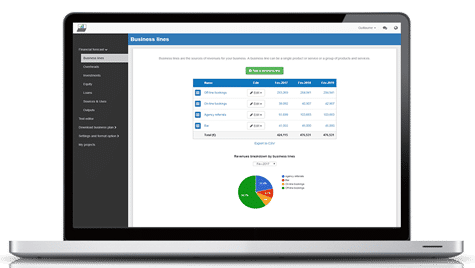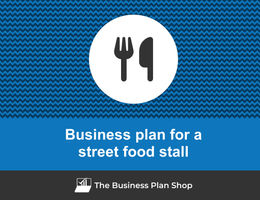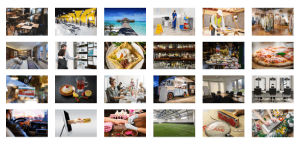How to create a financial forecast for a street food stall?
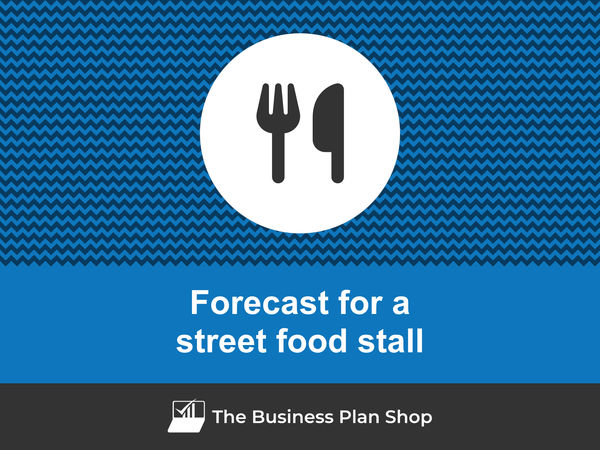
Creating a financial forecast for your street food stall, and ensuring it stays up to date, is the only way to maintain visibility on future cash flows.
This might sound complex, but with the right guidance and tools, creating an accurate financial forecast for your street food stall is not that hard.
In this guide, we'll cover everything from the main goal of a financial projection, the data you need as input, to the tables that compose it, and the tools that can help you build a forecast efficiently.
Without further ado, let us begin!
Why create and maintain a financial forecast for a street food stall?
Creating and maintaining an up-to-date financial forecast is the only way to steer the development of your street food stall and ensure that it can be financially viable in the years to come.
A financial plan for a street food stall enables you to look at your business in detail - from income to operating costs and investments - to evaluate its expected profitability and future cash flows.
This gives you the visibility needed to plan future investments and expansion with confidence.
And, when your trading environment gets tougher, having an up to date street food stall forecast enables you to detect potential upcoming financing shortfalls in advance, enabling you to make adjustments or secure financing before you run out of cash.
It’s also important to remember that your street food stall's financial forecast will be essential when looking for financing. You can be 100% certain that banks and investors will ask to see your numbers, so make sure they’re set out accurately and attractively.
Need a solid financial forecast?
The Business Plan Shop does the maths for you. Simply enter your revenues, costs and investments. Click save and our online tool builds a three-way forecast for you instantly.
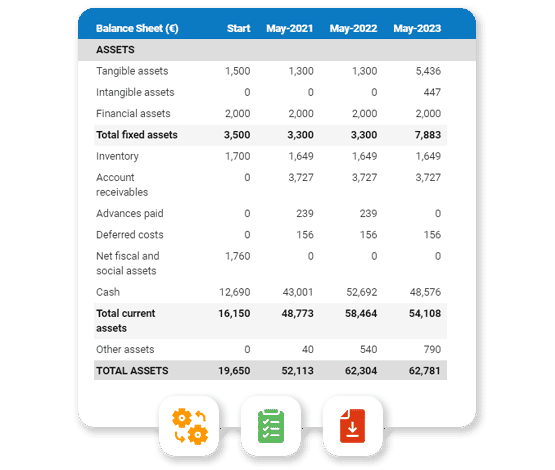
What information is used as input to build a street food stall financial forecast?
A street food stall's financial forecast needs to be built on the right foundation: your assumptions.
The data required to create your assumptions will depend on whether you are a new or existing street food stall.
If you are creating (or updating) the forecast of an existing street food stall, then your main inputs will be historical accounting data and operating metrics, and your team’s view on what to expect for the next three to five years.
If you are building financial projections for a new street food stall startup, you will need to rely on market research to form your go-to-market strategy and derive your sales forecast.
For a new venture, you will also need an itemised list of resources needed for the street food stall to operate, along with a list of equipment required to launch the venture (more on that below).
Now that you understand what is needed, let’s have a look at what elements will make up your street food stall's financial forecast.
The sales forecast for a street food stall
From experience, it is usually best to start creating your street food stall financial forecast by your sales forecast.
To create an accurate sales forecast for your street food stall, you will have to rely on the data collected in your market research, or if you're running an existing street food stall, the historical data of the business, to estimate two key variables:
- The average price
- The number of monthly transactions
To get there, you will need to consider the following factors:
- Weather conditions: It is important to take into account the weather conditions when forecasting your sales. For example, during the summer months, the demand for your street food may increase due to the warmer weather and people being out and about more often. However, during the colder months, the demand may decrease, impacting your average price and number of transactions.
- Local events and festivals: Keep an eye on any local events or festivals that may be happening in your area. These events can attract a large number of people, providing a potential increase in sales for your street food stall. However, if there are multiple events happening at the same time, it may impact the number of transactions you receive as people may have more options to choose from.
- Tourism season: Depending on the location of your street food stall, the tourism season can greatly impact your sales. If your stall is located in a popular tourist destination, you may see an increase in both average price and number of transactions during peak tourist season. However, during the off-season, you may experience a decrease in sales.
- Competition: It's important to keep an eye on your competitors in the street food market. If there are other food stalls offering similar products in the same location, it may impact your average price and number of transactions. Consider adjusting your prices and offerings to stay competitive in the market.
- Local economy: The state of the local economy can also impact your sales forecast. During times of economic downturn, people may be more conscious of their spending and may opt for cheaper options. On the other hand, during a booming economy, people may be more willing to spend money on street food, potentially increasing your average price and number of transactions.
Once you have an idea of what your future sales will look like, it will be time to work on your overhead budget. Let’s see what this entails.
Need inspiration for your business plan?
The Business Plan Shop has dozens of business plan templates that you can use to get a clear idea of what a complete business plan looks like.
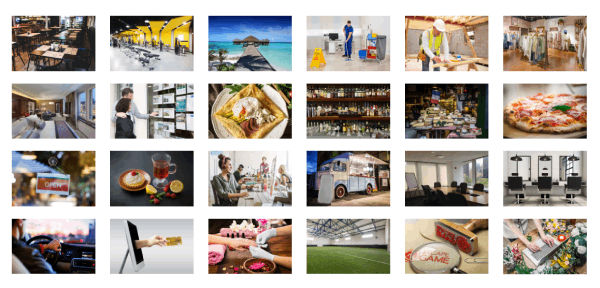
The operating expenses for a street food stall
The next step is to estimate the expenses needed to run your street food stall on a day-to-day basis.
These will vary based on the level of sales expected, and the location and size of your business.
But your street food stall's operating expenses should include the following items at a minimum:
- Food and Ingredients: This includes the cost of purchasing all the necessary ingredients and supplies to prepare your dishes. This could include items such as meat, vegetables, spices, and packaging materials.
- Staff Costs: As a street food stall, you will likely have a small team of employees to help with food preparation, service, and cleaning. Be sure to factor in their wages, taxes, and any benefits or bonuses you offer.
- Rent/Utilities: Whether you are operating out of a food truck or a rented space, you will have to pay for rent and utilities such as electricity, water, and gas.
- Permits and Licenses: In order to legally operate your street food stall, you will need to obtain various permits and licenses. These could include health permits, food handling permits, and business licenses.
- Accountancy Fees: It is important to keep track of your finances and stay on top of tax obligations. You may need to hire an accountant to help you with bookkeeping, tax preparation, and financial planning.
- Marketing and Advertising: To attract customers, you will need to invest in marketing and advertising efforts. This could include creating flyers, social media promotions, and participating in local events.
- Insurance Costs: As a business owner, it is important to protect yourself and your business from potential risks. Be sure to budget for insurance coverage such as liability insurance and property insurance.
- Equipment Maintenance: Your street food stall will likely rely on various equipment such as grills, fryers, and refrigerators. Make sure to account for regular maintenance and repairs to keep your equipment in good working condition.
- Software Licenses: In today's digital age, you may need to invest in software to help with tasks such as inventory management, accounting, and online ordering. Be sure to budget for any necessary software licenses.
- Banking Fees: As a business owner, you will need to open a business bank account and may incur fees for services such as transactions, wire transfers, and overdrafts.
- Cleaning Supplies: Maintaining a clean and sanitary environment is crucial for a street food stall. Be sure to budget for cleaning supplies such as soap, paper towels, and disinfectants.
- Packaging Materials: If you offer take-away options, you will need to budget for packaging materials such as containers, bags, and utensils.
- Telephone/Internet: In order to communicate with customers and suppliers, you may need to have a dedicated business phone line and internet connection.
- Transportation Costs: Depending on your location, you may need to factor in transportation costs for obtaining ingredients and supplies, as well as traveling to and from events or markets.
- Training and Development: Investing in your own skills and knowledge as a street food stall owner is important for your business's success. Consider budgeting for workshops, courses, or conferences related to food, business, or marketing.
This list is, of course, not exhaustive, and you'll have to adapt it according to your precise business model and size. A small street food stall might not have the same level of expenditure as a larger one, for example.
What investments are needed to start or grow a street food stall?
Once you have an idea of how much sales you could achieve and what it will cost to run your street food stall, it is time to look into the equipment required to launch or expand the activity.
For a street food stall, capital expenditures and initial working capital items could include:
- Food Truck/Trailer: This is the most essential fixed asset for your street food stall. It includes the cost of purchasing or renting a food truck or trailer, as well as any necessary modifications or equipment installations.
- Kitchen Equipment: You will need to purchase or lease cooking and food preparation equipment, such as grills, fryers, refrigerators, and food storage containers.
- Point of Sale (POS) System: A POS system is necessary for accepting payments and tracking sales. This includes the cost of purchasing or leasing a POS system, as well as any necessary software and accessories.
- Generator/Power Supply: If your street food stall will be operating in locations without access to electricity, you will need to invest in a generator or alternative power supply to run your equipment and lighting.
- Signage and Branding: In order to attract customers and stand out among other food stalls, you may need to invest in custom signage and branding materials, such as banners, menus, and logo design.
Again, this list will need to be adjusted according to the specificities of your street food stall.
Need a convincing business plan?
The Business Plan Shop makes it easy to create a financial forecast to assess the potential profitability of your projects, and write a business plan that’ll wow investors.
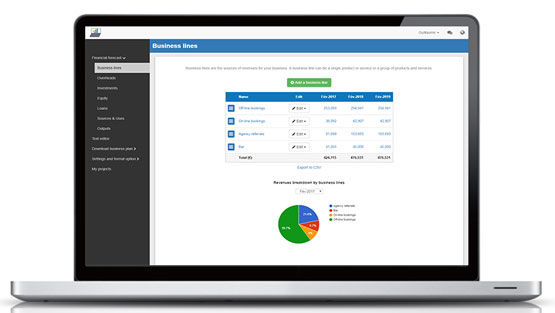
The financing plan of your street food stall
The next step in the creation of your financial forecast for your street food stall is to think about how you might finance your business.
You will have to assess how much capital will come from shareholders (equity) and how much can be secured through banks.
Bank loans will have to be modelled so that you can separate the interest expenses from the repayments of principal, and include all this data in your forecast.
Issuing share capital and obtaining a bank loan are two of the most common ways that entrepreneurs finance their businesses.
What tables compose the financial plan for a street food stall?
Now let's have a look at the main output tables of your street food stall's financial forecast.
The projected profit & loss statement
The projected profit & loss shows how profitable your street food stall is likely to be in the years to come.
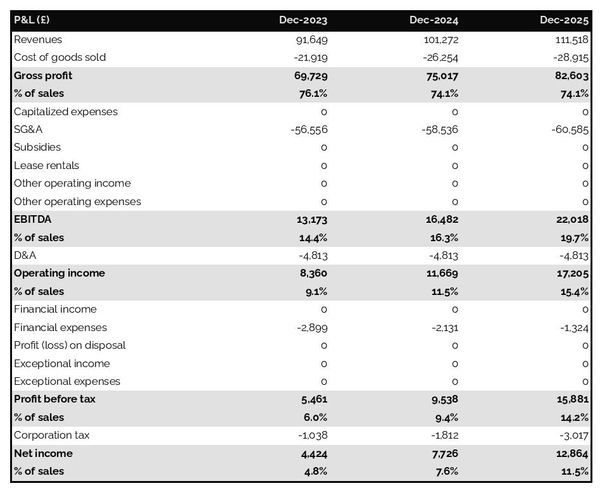
For your street food stall to be financially viable, your projected P&L should ideally show:
- Sales growing above inflation (the higher the better)
- Profit margins which are stable or expanding (the higher the better)
- A net profit at the end of each financial year (the higher the better)
This is for established street food stalls, there is some leniency for startups which will have numbers that will look a bit different than existing businesses.
The projected balance sheet
The projected balance sheet gives an overview of your street food stall's financial structure at the end of the financial year.
It is composed of three categories of items: assets, liabilities and equity:
- Assets: are what the business possesses and uses to produce cash flows. It includes resources such as cash, buildings, equipment, and accounts receivable (money owed by clients).
- Liabilities: are the debts of your street food stall. They include accounts payable (money owed to suppliers), taxes due and bank loans.
- Equity: is the combination of what has been invested by the business owners and the cumulative profits to date (which are called retained earnings). Equity is a proxy for the value of the owner's stake in the business.
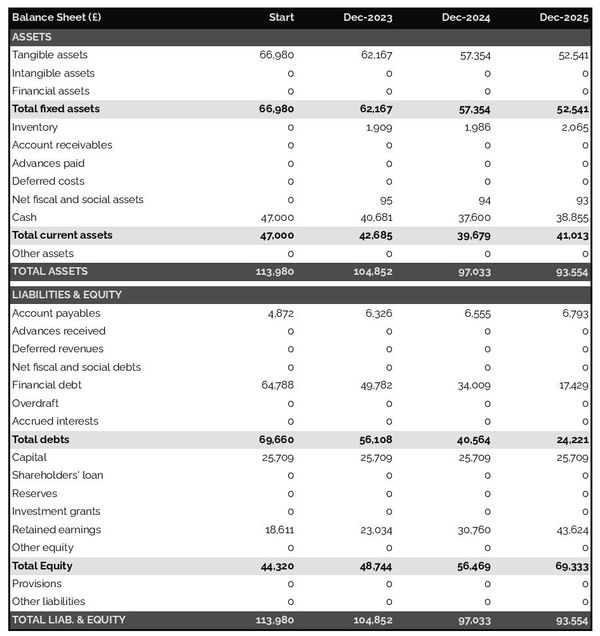
The cash flow forecast
Your street food stall's cash flow forecast shows how much cash your business is expected to consume or generate in the years to come.
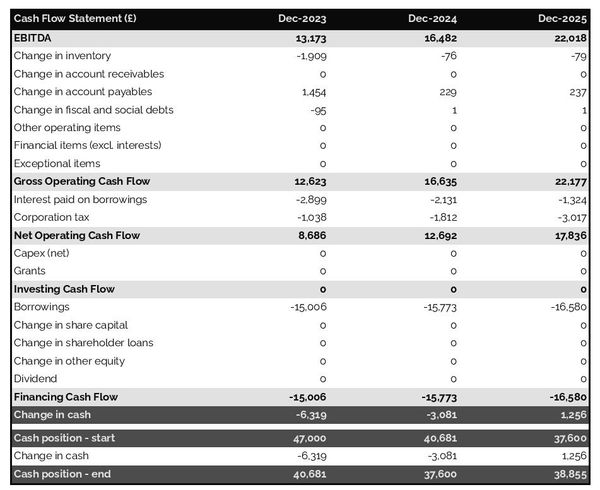
It is best practice to organise the cash flow forecast by nature to better explain where cash is used or generated by the street food stall:
- Operating cash flow: shows how much cash is generated by the operating activities
- Investing cash flow: shows how much will be invested in capital expenditure to maintain or expand the business
- Financing cash flow: shows if the business is raising new capital or repaying financiers (debt repayment, dividends)
Keeping an eye on (and regularly updating) your street food stall's cash flow forecast is key to ensuring that your business has sufficient liquidity to operate normally and to detect financing requirements as early as possible.
If you are trying to raise capital, you will normally be asked to provide a monthly cash flow forecast in your street food stall's financial plan - so that banks or investors can assess seasonal variation and ensure your business is appropriately capitalised.
Need a solid financial forecast?
The Business Plan Shop does the maths for you. Simply enter your revenues, costs and investments. Click save and our online tool builds a three-way forecast for you instantly.

Which tool should you use to create your street food stall's financial forecast?
Using the right tool or solution will make the creation of your street food stall's financial forecast much easier than it sounds. Let’s explore the main options.
Using online financial forecasting software to build your street food stall's projections
The modern and easiest way is to use professional online financial forecasting software such as the one we offer at The Business Plan Shop.
There are several advantages to using specialised software:
- You can easily create your financial forecast by letting the software take care of the financial calculations for you without errors
- You have access to complete financial forecast templates
- You get a complete financial forecast ready to be sent to your bank or investors
- You can easily track your actual financial performance against your financial forecast, and recalibrate your forecast as the year goes by
- You can create scenarios to stress test your forecast's main assumptions
- You can easily update your forecast as time goes by to maintain visibility on future cash flows
- You have a friendly support team on standby to assist you when you are stuck
- It’s cost-efficient and much cheaper than using an accountant or consultant (see below)
If you are interested in this type of solution, you can try our forecasting software for free by signing up here.
Hiring a financial consultant or chartered accountant
Hiring a consultant or chartered accountant is also an efficient way to get a professional street food stall financial projection.
As you can imagine, this solution is much more expensive than using software. From experience, the creation of a simple financial forecast over three years (including a balance sheet, income statement, and cash flow statement) is likely to start around £700 or $1,000 excluding taxes.
The indicative estimate above, is for a small business, and a forecast done as a one-off. Using a financial consultant or accountant to track your actuals vs. forecast and to keep your financial forecast up to date on a monthly or quarterly basis will naturally cost a lot more.
If you choose this solution, make sure your service provider has first-hand experience in your industry, so that they may challenge your assumptions and offer insights (as opposed to just taking your figures at face value to create the forecast’s financial statements).
Why not use a spreadsheet such as Excel or Google Sheets to build your street food stall's financial forecast?
Creating an accurate and error-free street food stall financial forecast on Excel (or any spreadsheet) is very technical and requires both a strong grasp of accounting principles and solid skills in financial modelling.
Most entrepreneurs lack the expertise required to create an accurate financial forecast using spreadsheet software like Excel or Google Sheets. As a result, it is unlikely anyone will trust your numbers.
The second reason is that it is inefficient. Building forecasts on spreadsheets was the only option in the 1990s and early 2000s, nowadays technology has advanced and software can do it much faster and much more accurately.
This is why professional forecasters all use software. With the rise of AI, software is also becoming smarter at helping us detect mistakes in our forecasts and helping us analyse the numbers to make better decisions.
Finally, like everything with spreadsheets, tracking actuals vs. forecasts and updating your forecast as the year progresses is manual, tedious, error-prone, and time-consuming. Whereas financial forecasting software like The Business Plan Shop is built for this.
Need a convincing business plan?
The Business Plan Shop makes it easy to create a financial forecast to assess the potential profitability of your projects, and write a business plan that’ll wow investors.

Use our financial projection templates for inspiration
The Business Plan Shop has dozens of financial forecasting templates available.
Our examples contain both the financial forecast, and a written business plan which presents, in detail, the company, the team, the strategy, and the medium-term objectives.
Whether you are just starting out or already have your own street food stall, looking at our template is always a good way to get ideas on how to model financial items and what to write when creating a business plan to secure funding.
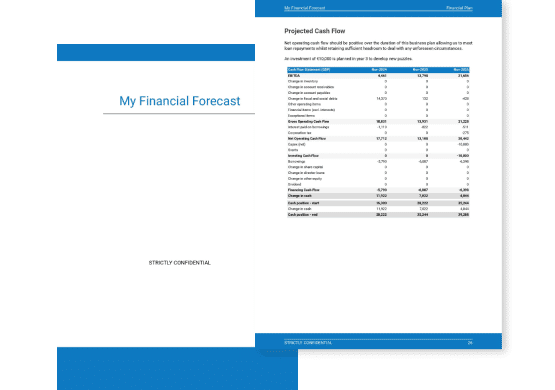
Takeaways
- A financial forecast shows expected growth, profitability, and cash generation metrics for your street food stall.
- Tracking actuals vs. forecast and having an up-to-date financial forecast is key to maintaining visibility on your future cash flows.
- Using financial forecasting software is the modern way of creating and maintaining financial projections.
We hope that this guide helped you gain a clearer perspective on the steps needed to create the financial forecast for a street food stall. Don't hesitate to contact us if you have any questions!
Need inspiration for your business plan?
The Business Plan Shop has dozens of business plan templates that you can use to get a clear idea of what a complete business plan looks like.

Also on The Business Plan Shop
Know someone who runs a street food stall? Share our business guide with them!

